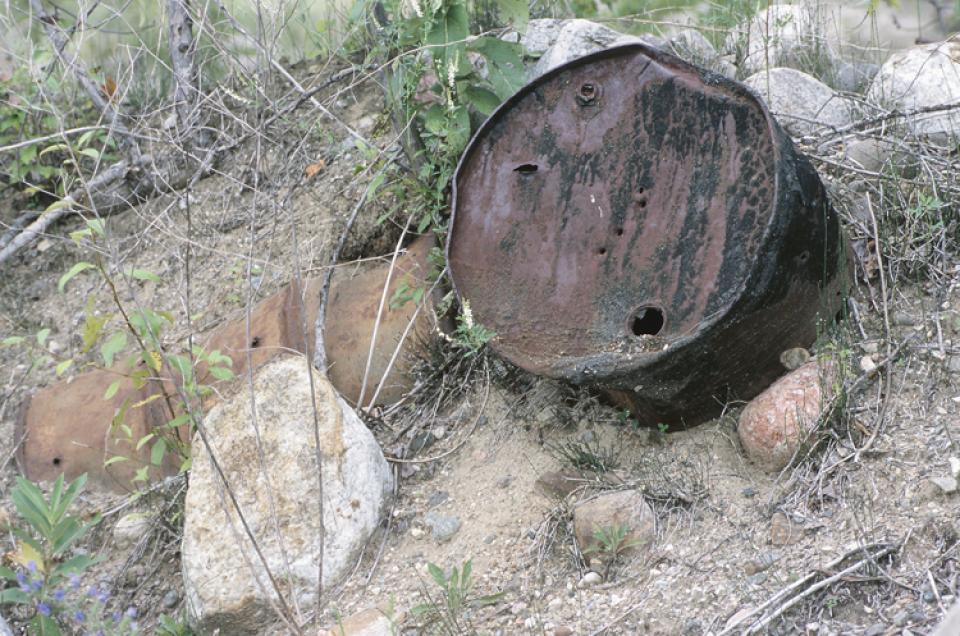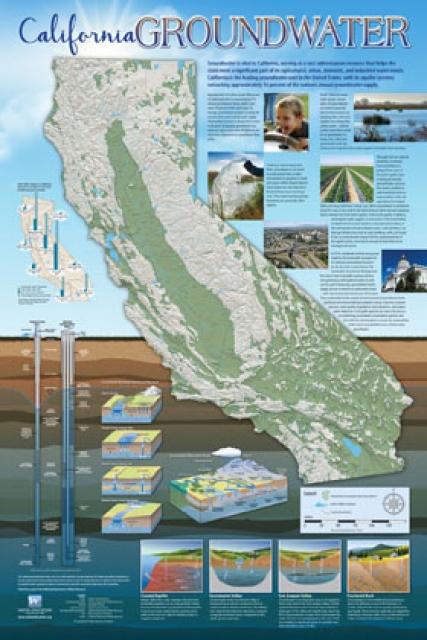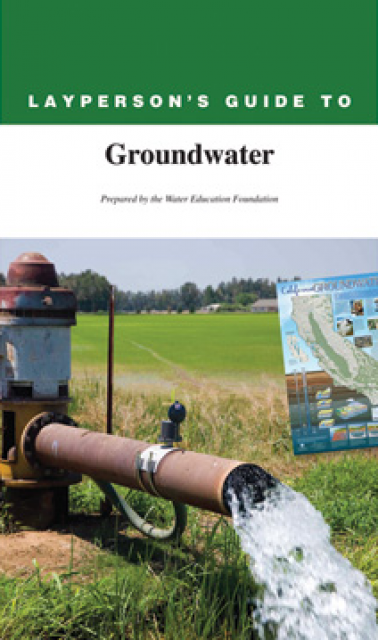Groundwater Pollutants
The natural quality of groundwater in California depends on the surrounding geology and on the source of water that recharges the aquifer.
For instance, snow melt streaming down (or through) the granite and volcanic rocks of the Sierra Nevada or Cascade Mountains remains fairly pure as it seeps into aquifers on the east side of the Central Valley. However, water flowing through the marine sedimentary rocks that comprise the Coast Ranges picks up natural minerals and elements, as does water flowing through the west side of the Central Valley. (West Valley growers use agricultural drainage tiles to drain off salty, mineral-laden waters.)
Groundwater and Pollutants Overview
Prior to environmental regulations being enacted in the 1970s, military bases and industrial facilities dumped fuels, used solvents and other liquid wastes into pits, where the pollutants leached into the groundwater.
Other sources of groundwater pollutants included:
- gasoline tanks buried in the ground
- garbage dumps built with inadequate safeguards or none at all
- agricultural chemicals
- residential septic tanks and agricultural feedlots also are sources for nitrates, bacteria and viruses
- wells that were abandoned or improperly constructed
- stormwater runoff
In many of these cases, the pollutants overwhelmed the natural ability of the soils to filter out the pollution, or the pollutants passed through the soil in a shorter time than required for decomposition or consumption by organisms in the soil.
Natural Elements of Groundwater Pollution
In California, nitrate is one of the most common groundwater contaminants, leaching into the soil and from there into the water supply from various sources. Nitrate occurs naturally in soil and dissipates when the soil is extensively farmed. Irrigation water containing fertilizers is a common culprit as are septic systems, wastewater treatment plants, dairies and natural conditions.
Learn more about pollutants and groundwater in this video.
Some groundwater is also polluted with other natural elements leached from the earth, including radon, boron and arsenic.
Boron is an element that is an essential micro-nutrient but toxic to plants in slightly greater concentrations. Boron is found in groundwater in concentrations harmful to plants in the northern and southwestern Sacramento Valley and in parts of the San Joaquin River and Tulare Lake basins.
Mercury, chromium and selenium have been found in wells in the western San Joaquin Valley at concentrations that exceed federal wildlife standards. Arsenic, hydrogen sulfide and radon are all leached out of the soils by percolating groundwater and can be found in California’s aquifers.
Arsenic is a semi-metallic element used in wood preservatives, agricultural chemicals, herbicides and pesticides. It is known for its toxicity to humans — ingestion of as little as 100 milligrams, or one thousandth of a gram, usually results in severe poisoning. Arsenic occurs naturally in some soils, which can result in quantities of the substance in groundwater at low concentrations.
The federal Environmental Protection Agency and California have set the arsenic standard for drinking water at 10 parts per billion (ppb). According to the California State Water Resources Control Board, in 2021 more than 800 drinking water wells had arsenic levels above the federal standard.
Urban and Industrial Pollutants
Urban pollution comes from leaking tanks and sewers, industrial waste discharges, commercial facilities, failed septic systems and old and current landfills. One source of pollution is leaking underground fuel tanks, many of them from neighborhood gas stations. The leaking fuel contains a number of chemicals, some of which are associated with cancer, and in some places the tanks have polluted groundwater. Cleanup of the tanks, contaminated soil and the groundwater beneath them in some cases has been paid for by a special tax on fuels.
As of 2021, there were 1,995 active leaking underground fuel tank cases in California and 40,081 cleanup projects had been completed. According to the State Water Board, an estimated 500 underground storage tanks are suspected of leaking petroleum chemicals or their status is unknown.
Response to Groundwater Pollutants
Prevention has become a key focus because once a basin is contaminated it is difficult, expensive and generally impossible to remove contaminants. Many groundwater basins may remain contaminated for hundreds of years or more, according to DWR. Activists say improvements have to be made in the monitoring of groundwater pollution in order for state and federal agencies to have a clear picture of the extent of contamination.
Such contamination is an increasing concern because of the potential health threats and the compromised ability of affected aquifers to meet growing water demands.
In response, groundwater is treated, though in different ways in different communities depending on what contaminants the water contains.
The water may be treated as it is pumped from the ground to remove certain contaminants or it may be chlorinated as described above if there is concern of bacterial or parasitic infection.











